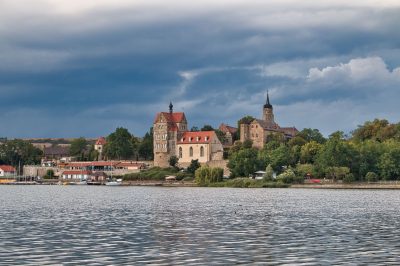Halle-Neustadt – considered by many to be an urban development nightmare, a welfare ghetto and the fringe not only of the city of Halle Germany, but of society. Today, Ha-Neu, as the residents call the city in reference to the Vietnamese capital, is a shadow of its former self. For Halle-Neustadt was once a paradise and built as a planned city for chemical workers. Up to 110,000 people were to live in the largest new city in Germany after the war. By 1989, Halle-Neustadt had grown to 90,000 inhabitants. Only 45,000 remain, but even today there are many buildings that remind us of the once promising future of this socialist city. Come with us on a journey back in time to the GDR.

City for athe workers of the Leuna and Buna industrial complexes in Halle Germany
With the construction of the Druzhba (Russian for friendship) oil pipeline, the GDR began to build new petrochemical plants. The Buna and Leuna chemical plants were already huge industrial facilities before and during World War II. With the expansion in the GDR, however, they grew into massive complexes that employed tens of thousands of workers. Buna employed 18,000 workers, and Leuna as many as 30,000. These workers needed one thing above all: housing. The cities and villages in the surrounding area, which had been heavily destroyed during the war, could not accommodate the large number of workers. The journey times to the workplaces were up to two hours. The GDR government aimed to build a city for the chemical workers. Halle-Neustadt was an important object in GDR propaganda.
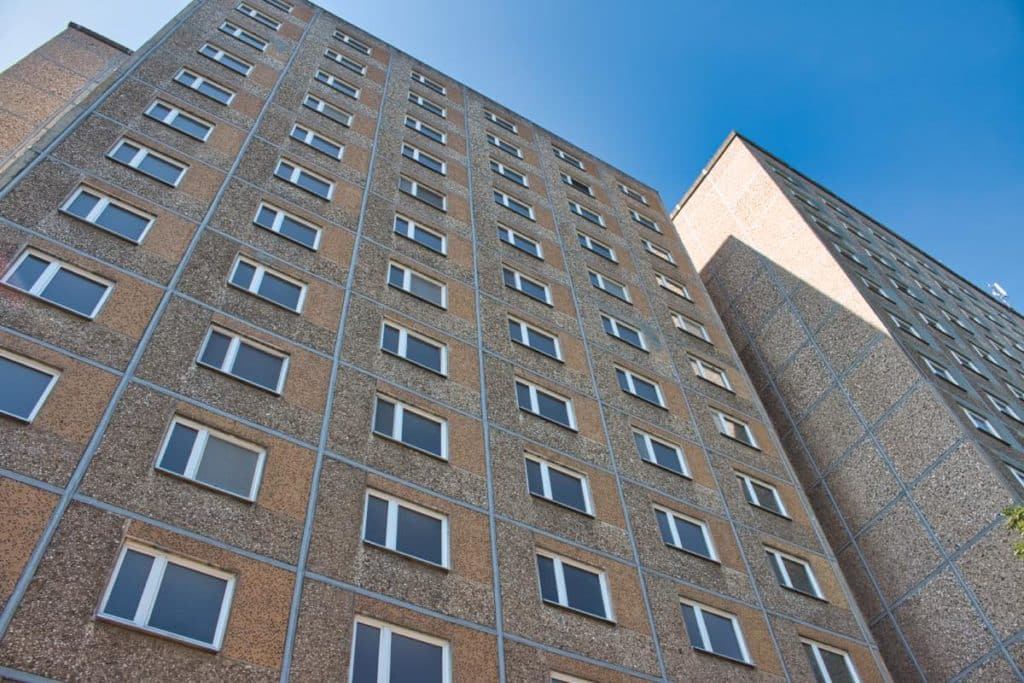
Start of construction for Halle-Neustadt
The construction of Halle-Neustadt was decided in 1958 at a conference of the Central Committee of the SED. In 1963, the Politburo finally approved the construction of the chemical workers’ city. Upon completion, the city was to provide a home for up to 110,000 people. A separate concrete slab factory was even built for the construction, which began operations in 1964 and was able to complete 2,000 apartments per year.
The architect responsible for the planning was Richard Paulick, who had worked at the Bauhaus before the war and had also designed parts of Stalinallee in Berlin. However, the first building in the residential town was a school, the 1st POS, for which the foundation stone was laid on July 15, 1964. On August 9, 1965, the first chemical workers and their families moved into the new cooperative apartments. In 1967, Halle-Neustadt was already granted municipal status and was administered independently of Halle (Saale). By 1975, 50,000 people were living in the city, and by 1981, 90,000.



Residential complexes – Everything reachable in 6 to 8 minutes
Halle-Neustadt was already divided into housing complexes during the planning phase. Thus, more and more of these housing estates were gradually created, which were then to form the city of Halle-Neustadt. In accordance with socialist ideology, managers lived here next to bricklayers. According to the guidelines for the construction of socialist cities, the housing complexes were each to cover all the important needs of the residents. Here are the schools, utilities and recreational facilities, polyclinics and restaurants. There were also kindergartens in each housing complex, because women in the GDR were almost all working people. The centers of the housing complexes could each be reached in 6 to 8 minutes on foot. This was to give the socialist people more free time.
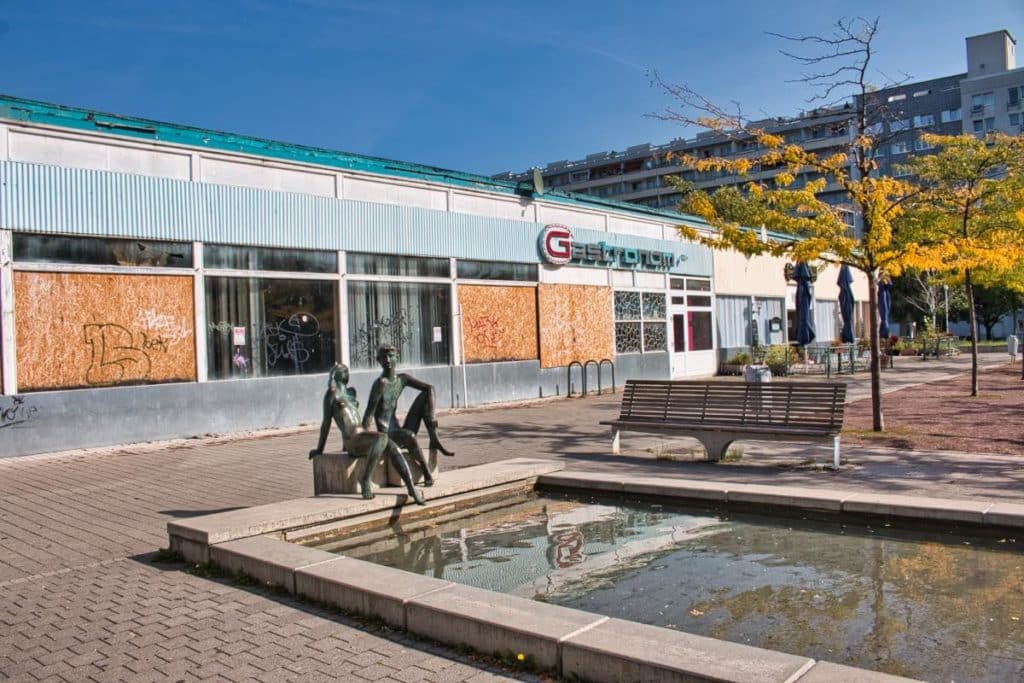
Block 10
When building the city, the authorities therefore did not shy away from superlatives. In 1967, the largest residential block in the GDR was built from 23,000 elements. Block 10 is 380 meters long. It contains 320 multi-room and 536 one-room apartments – living space for around 3,000 people. There are three passageways. There is a roof garden on the building. A daycare center and a nursing home also moved in. The building is still in use today.
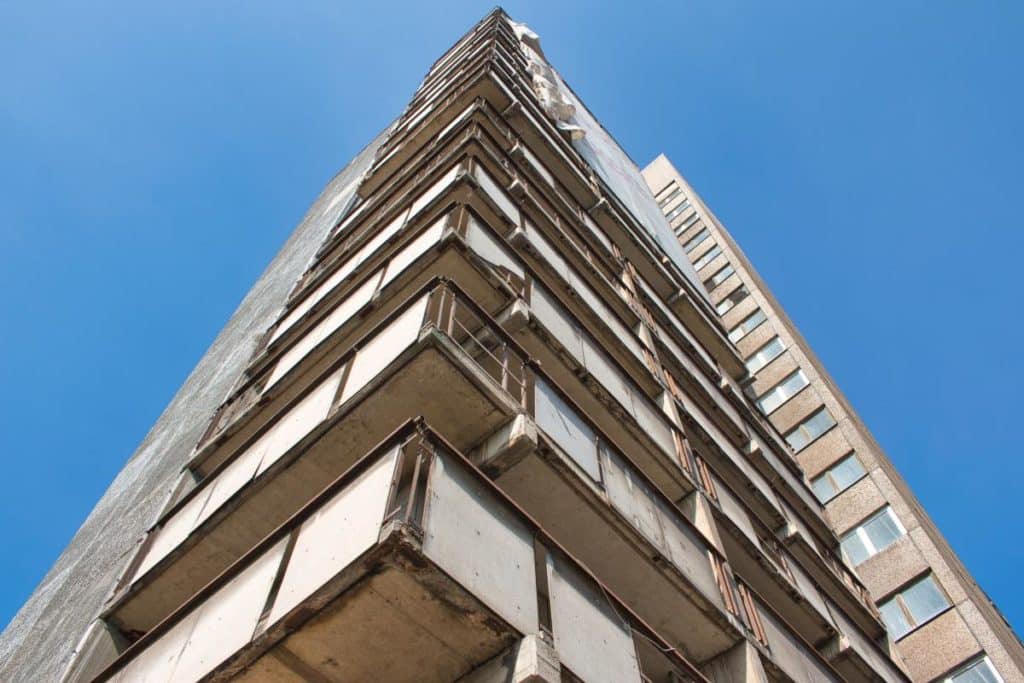

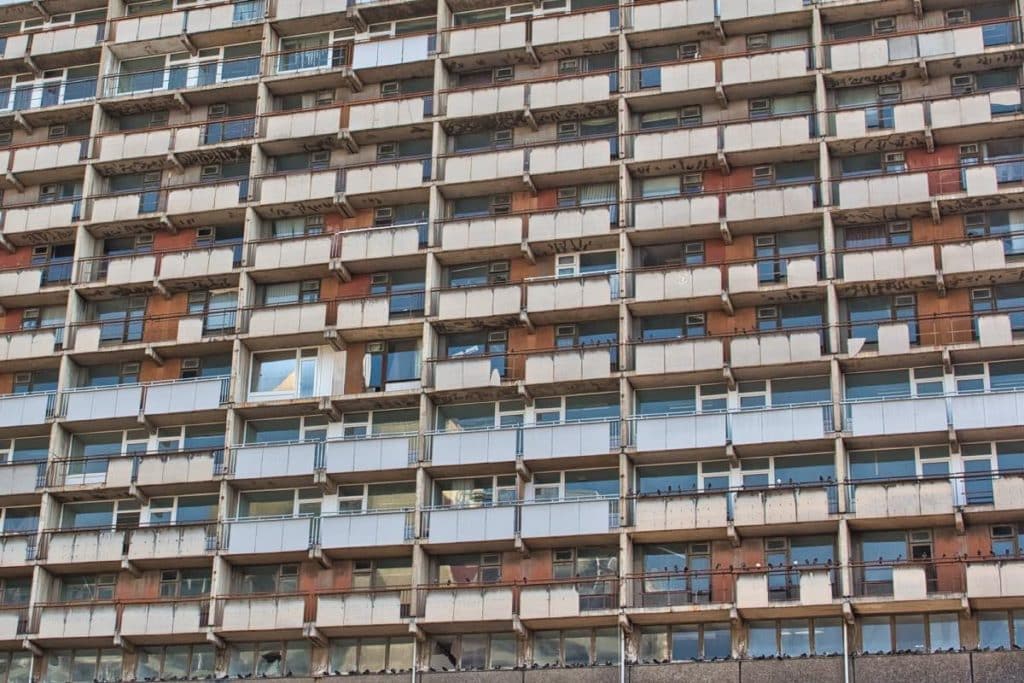

Neustädter Passage – Center of the city of chemical workers
In the center of the newly built city, an impressive urban ensemble was erected. Around und the Neustädter Passage, several high-rise disk buildings were raised, which are strongly reminiscent of the buildings on Leipziger Strasse in Berlin-Mitte. The panels are 18 stories high and their length is impressive in itself. At the moment, however, dreariness reigns here. Two of the windows are being renovated. The city administration wants to move into one of them. Another is to become a student dormitory. The only one that has already been renovated (panel D) is home to the employment agency. There used to be a café on the 18th floor. It was closed in 2015. What is to happen to the other panels is as yet unclear.
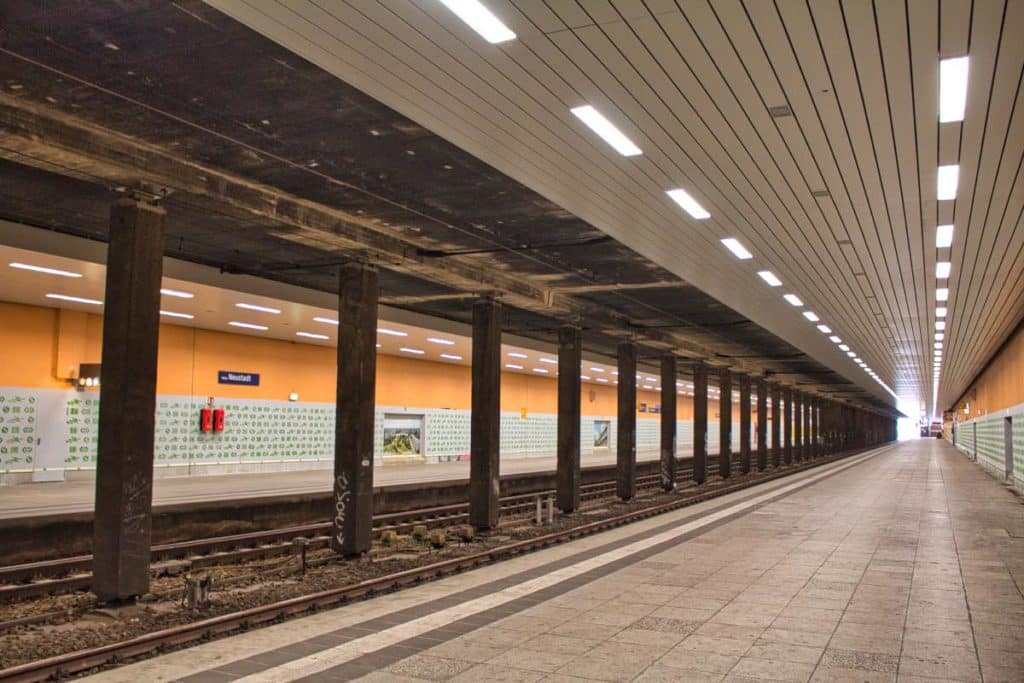
Transport in Halle-Neustadt – fast connection to the factories
In order to get the workers from their new homes to the factories as quickly as possible, a new rail line was built. A futuristic underground station was even built under the Neustädter Passage. From here, working people could get to Buna in just ten minutes and to Leuna in twenty. As was customary in socialist cities, large roads were built between the housing complexes. The planned city was given dead-straight streets. Bus lines with Ikarus buses supplemented the suburban train connection to enable rapid movement through Halle-Neustadt.
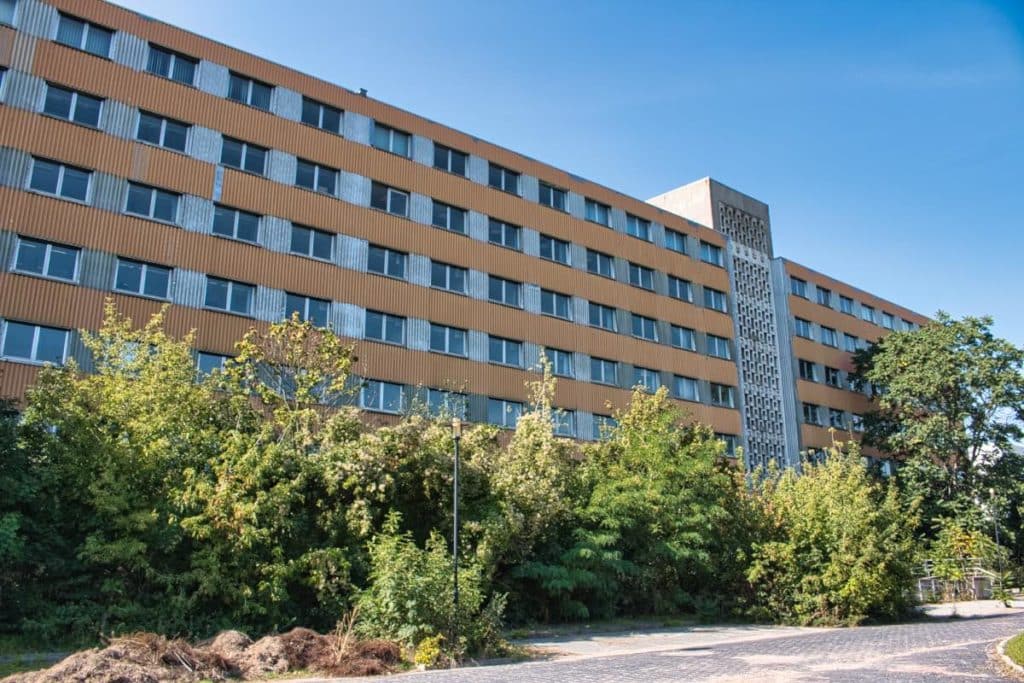
The Stasi and Control in Halle-Neustadt
Surveillance and control were included virtually from the beginning into the DNA of the buildings. In each block, there was a section officer of the party who watched over the residents. The Stasi (state security) had riddled the society with informal employees. And architecturally, the apartments were also easy to monitor: The Stasi had exact blueprints and knew where to plant bugs. The walls were also thin. But because Halle-Neustadt was a city for the new, socialist man, the SED-party also built the Stasi headquarters right here. Today, the building complex houses the Stasi documentation authority and, for a time, the local tax office was also located here.
Art in Halle-Neustadt
In Halle-Neustadt, attempts were made to integrate art into urban development and thus into people’s everyday lives. Among the best-known artists who created works in Halle-Neustadt were Willy Sitte and Willi Neubert.
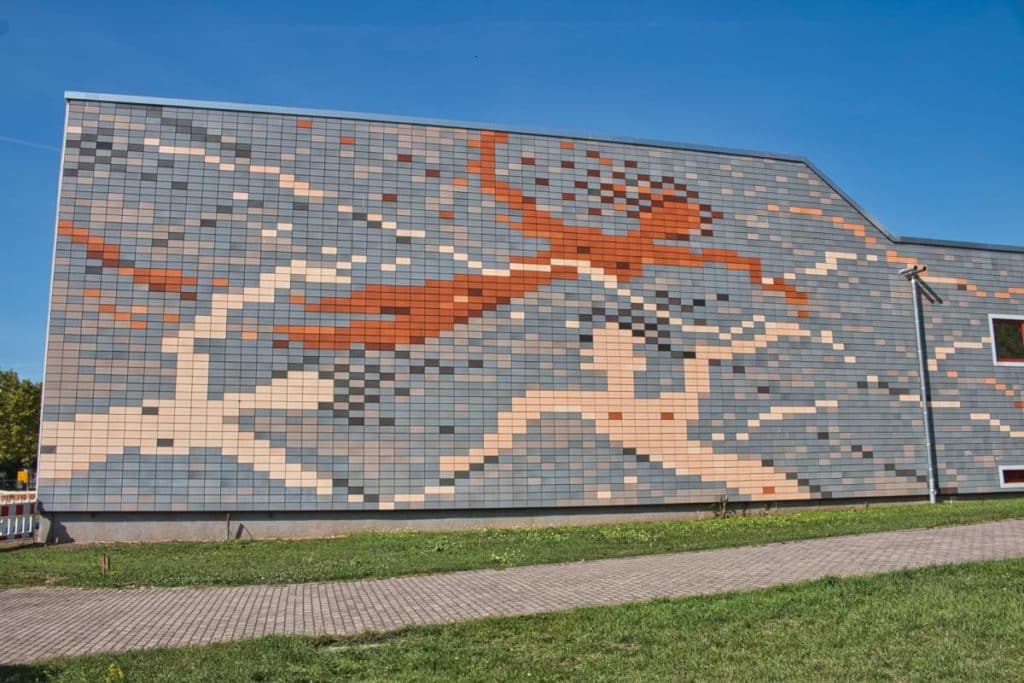
Murals and mosaics
Therefore, everywhere you can find huge mosaics or even small murals. In many places there are fountains, which were created as works of art, and sculptures.
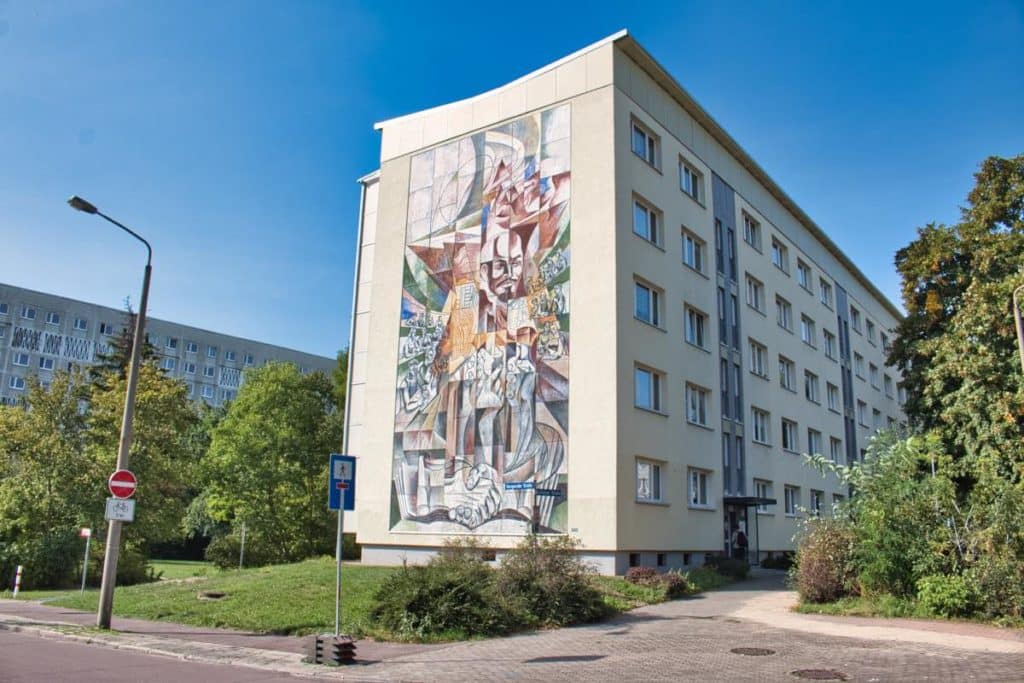
“He touched the sleep of the world” or how Lenin’s words come true
Erich Enge created this mural in 1970, commemorating the 100th anniversary of Lenin’s birth. The propaganda work alludes to Lenin’s three main achievements in the Soviet Union: his commitment to education, the electrification and industrialization of the Soviet Union, and the land reform that took away the land from the supposedly rich peasants.


The forces of nature and technology controlled by man
In 1974, José Renau created this mural for the gable of the staircase with the title “The forces of nature and technology controlled by man”. In the GDR, as in other communist countries, a veritable hysteria of progress had broken out as a result of the conquest of the cosmos. Propaganda and also state-commissioned art celebrated the achievements of socialist societies and celebrated their heroes. The picture depicts many of these objects: Struggle of the working class, skyscrapers, factories, rockets and, of course, the Soviet star.
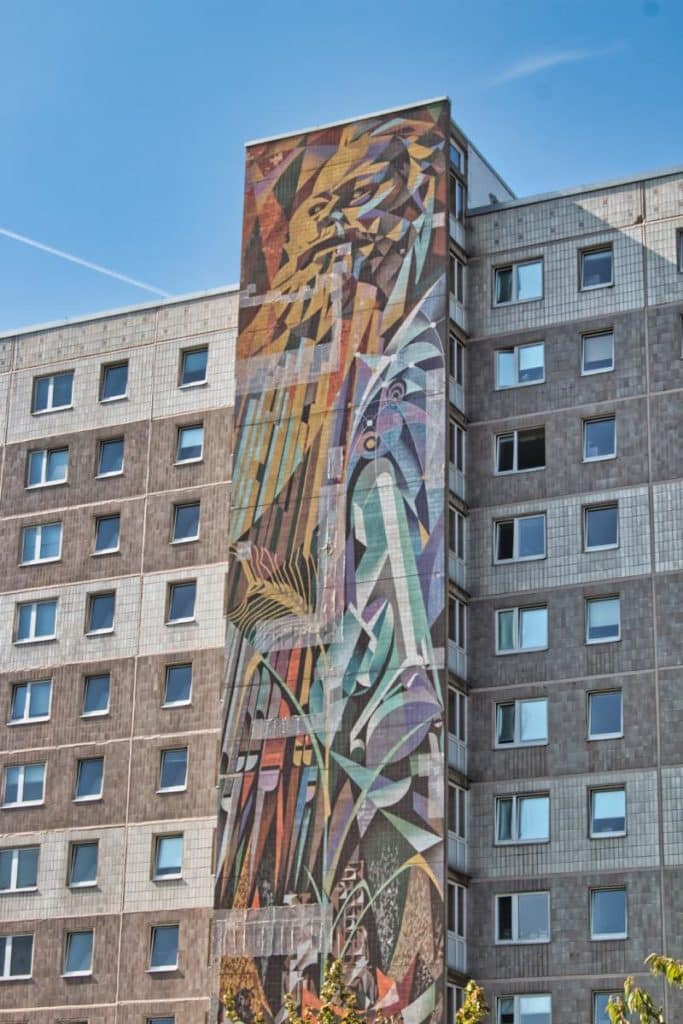
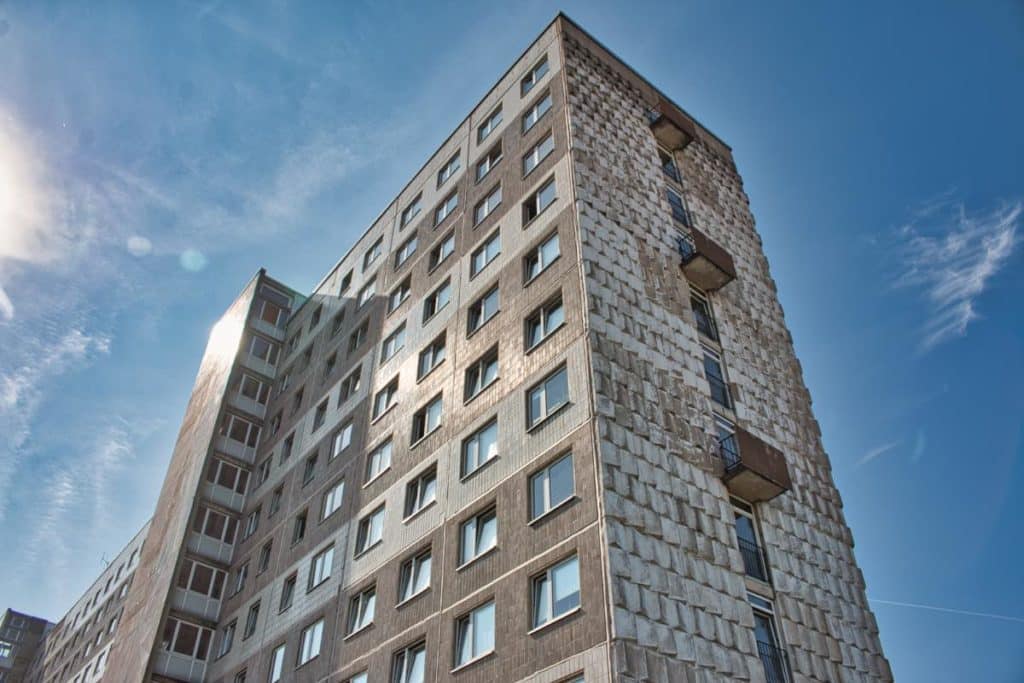
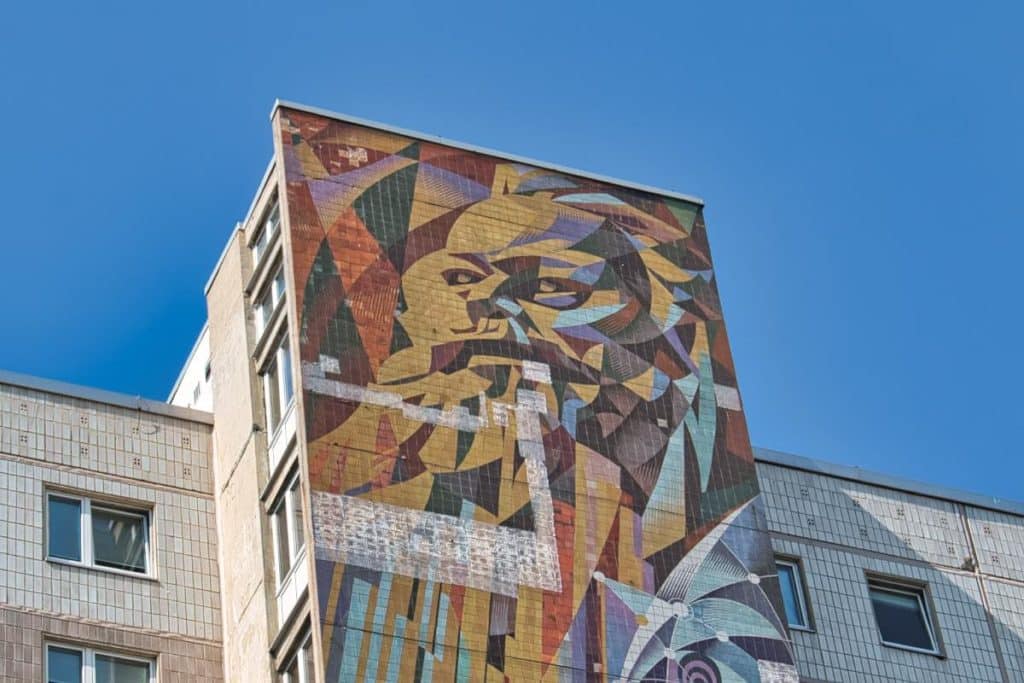
Unity of the working class and foundation of the GDR
Right next to it, Renau created the work Unity of the Working Class and Foundation of the GDR, which was attached to the gable of a second staircase. Actually, he wanted to deal with nature as opposed to technology. However, the party wanted a work about the unity of the working class and the founding of the GDR. The depicted symbols of the ear of grain, the microscope and the organ pipes focus on what was paid attention to in socialism: agriculture and land reform, science and technology, art and culture.

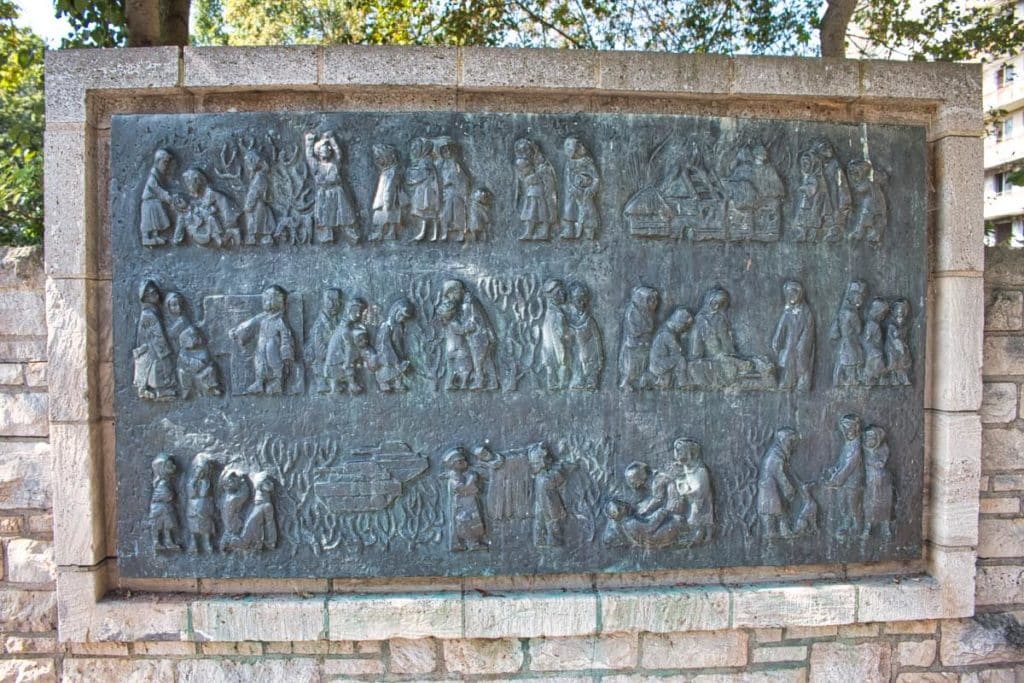
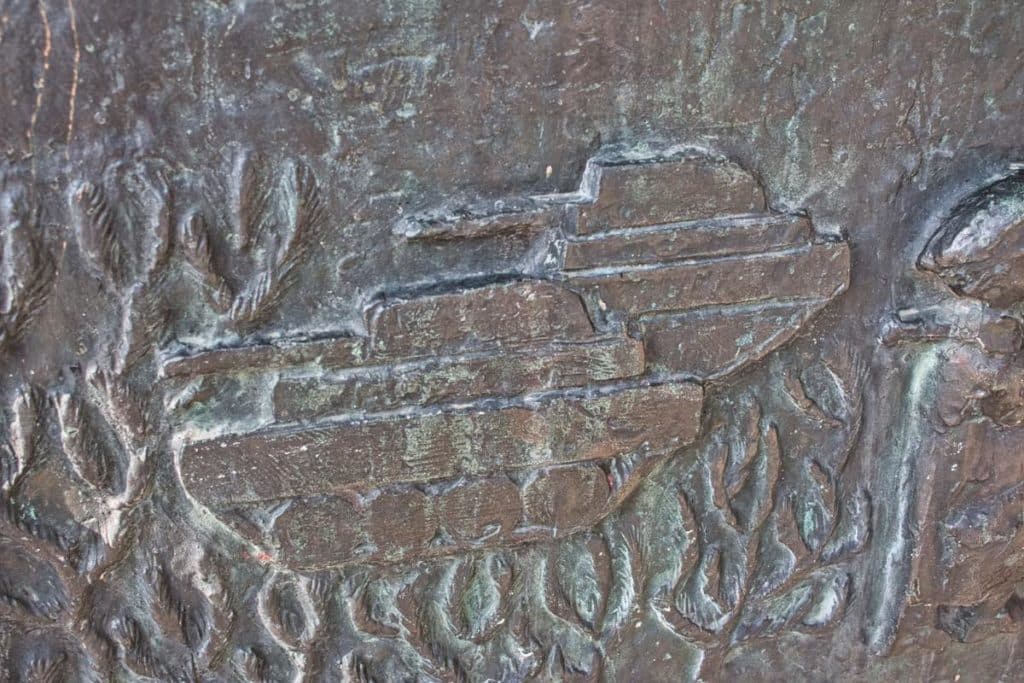

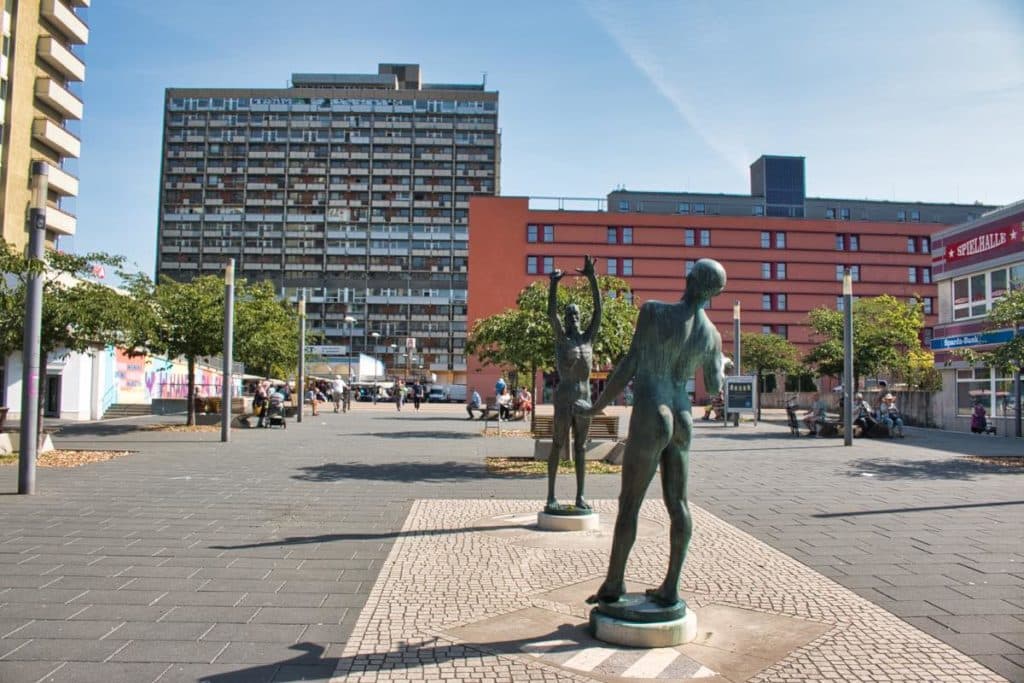
Fountains and sculptures
In addition to these huge monumental works, however, the SED also frequently commissioned smaller works of art from local artists. Thus, sculptures and fountains designed by them can be found throughout the Halle-Neustadt area. Many of them show motifs that sought to educate socialist people. Others were designed quite profanely or showed rather philosophical allusions. Feel free to look at the pictures in the gallery for a better insight.

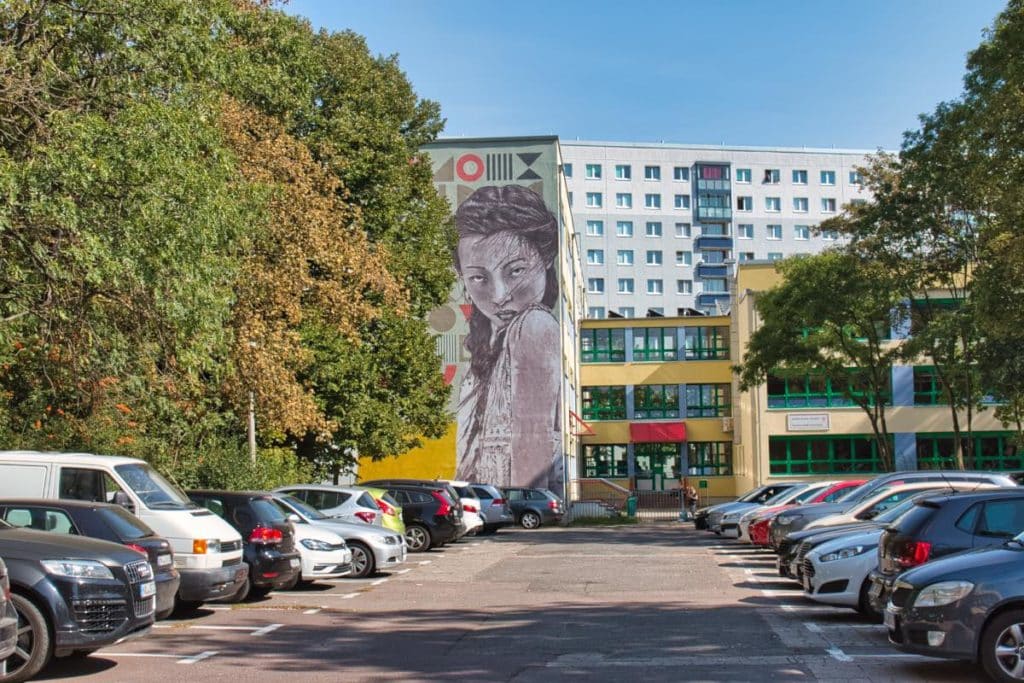
Halle-Neustadt after the end of the GDR
The once proud socialist city has changed a lot since 1990. As early as the year of reunification, a referendum determined that Halle-Neustadt should be annexed to Halle. Since May 1990, Halle-Neustadt has no longer been independent. Due to the closure of large parts of the combines and mass layoffs, many residents moved out of the city. About 45,000 still live in Ha-Neu today. Many of the formative buildings were demolished. Numerous residential buildings have been deconstructed or downsized. The former city of chemical workers is considered a social hotspot in parts. At least there are renovated schools, and the Halle Germany streetcar has been running to Neustadt for a long time. And the Neustädter Passage with its window panels is currently being renovated.
Book recommendations
There are no books in English about Halle-Neustadt in Halle Germany. However, these books give a good overview about socialist architecture in general.
No products found.
No products found.



